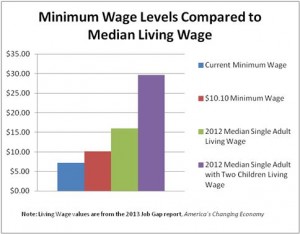Yesterday, the Congressional Budget Office released a report on the estimated effects of increasing the minimum wage to $10.10 and indexing it to inflation by 2016. Opponents of the increase have jumped on the report’s (questionable) conclusion that it would cost jobs, while many in favor of increasing the minimum wage have focused on the benefits, including lifting almost one million workers out of poverty.
However, even a minimum wage of $10.10 doesn’t come close to reaching a living wage that allows workers to move beyond living paycheck to paycheck. Our 15th annual Job Gap study, America’s Changing Economy, clearly shows that $15 – $16 per hour is the minimum pay needed to support a single adult working full time.
So, here are seven reasons not to let the CBO report discourage Congress from increasing the minimum wage from $7.25 to $10.10, and why we actually need an even higher minimum wage:

Increasing the minimum wage would help move almost 1 million Americans above the poverty line. However, a single parent living on minimum wage would still need federal assistance. While a wage of $10.10 would help a single parent with one child live without depending on food stamps, a parent with two or more children would still need that assistance, and even a parent with one child would qualify for educational aid. Increasing the minimum wage to $10.10 is a step in the right direction, but until workers can fully support themselves and their families with a minimum wage job, public programs must be strengthened to help families scrape by.
The overwhelming majority of economic studies on the effects of increasing the minimum wage show little to no job loss associated with a higher minimum wage. While the CBO report estimates about 500,000 jobs (0.3 percent) would be cut, studies like the one from 2013 by the Center for Economic and Policy Research show that, historically, minimum wage increases have had little to no impact on employment. Additionally, in a separate analysis of the impact of an increase on the minimum wage, the Economic Policy Institute found that increasing the minimum wage to $10.10 could actually have a “positive increase on job creation.”
The proposed increase is in line with the average increase of the minimum wage historically, but would raise the wages of more workers. In the years since the minimum wage was enacted, the average percent change of single-year increases has been 9.6 percent in real dollars; the proposed increase represents a change of 9.5 percent. Additionally, over the past 30 years, about 5 percent of workers earned between the old minimum wage and the new minimum wage when Congress legislated an increase; now, more than 10 percent of workers earn between the current minimum wage of $7.25 and the proposed minimum wage of $10.10 per hour, despite the increase matching historical levels. This is clear evidence of the shift to low-wage work discussed in the Alliance’s 2013 Job Gap report.
The majority of workers would benefit from increasing the minimum wage to $10.10. In addition to the workers who currently make between $7.25 and $10.10 per hour, most other workers with higher incomes would also see their real family income increase. As employers increase wages for low-income earners, they will be encouraged to increase wages for other employees, as well.
If the minimum wage kept pace with the income of the top 1 percent, it would be over $28 per hour. Minimum wage workers currently make only 37 percent of the average wage of all workers, and less than 4 percent of income for the top 1 percent of income earners. It hasn’t always been that way: through the 1960s, minimum wage was about half of the average wage, and even as recently as 1980 CEO pay was only 42 times greater than the salary of the average worker.
Increasing the minimum wage will generate economic activity. One area that is largely left out of the CBO report is the economic activity that increasing the minimum wage will generate. As Doug Hall, director of the Economic Analysis and Research Network at the Economic Policy Institute notes, “Lower-income earners spend their income more immediately, more completely, and more locally, than do higher income earners, and therefore generate more economic activity. [Increasing the minimum wage to $10.10] generates an additional GDP impact of $22 billion.”
$10.10 is still well below a living wage. Even with conservative calculations that provide just enough for a worker to provide for their family’s basic needs and have some money left over for savings and miscellaneous expenses, a living wage for a single adult with two children is still over $25 per hour in many parts of the country.
A person working full time should earn enough to cover the basics like food, housing, transportation, and child care, and still have enough left to save and to spend on miscellaneous goods and services at businesses in their communities. Increasing the minimum wage to $10.10 per hour will still leave many families falling short of that living wage standard, but that is all the more reason that Congress should act to increase the minimum wage.
Allyson Fredericksen is a Policy Associate at the Alliance for a Just Society.

